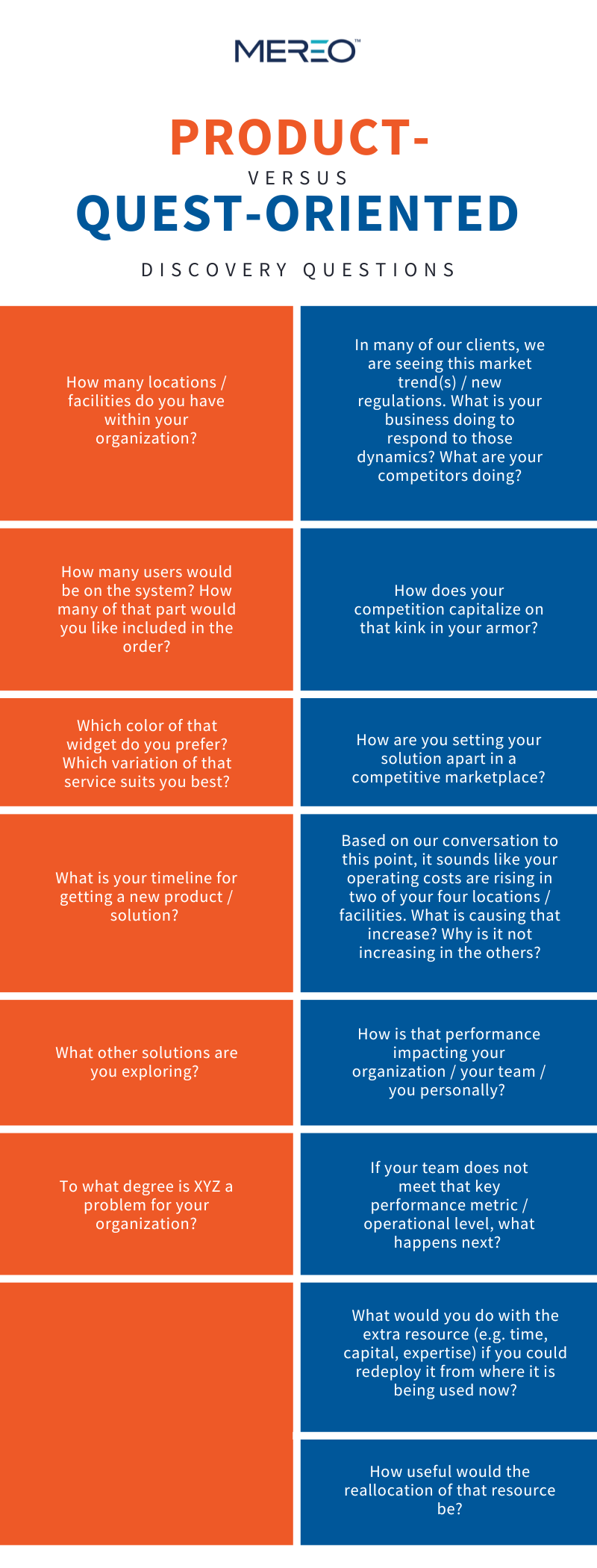In lead qualification and discovery, almost all sales thought leaders tout the same advice: asking questions is key. I could not agree more. Questions pave the way for insights, revelations and relationship-building. They can encourage a shared conversation instead of a salesperson droning on about a solution. Their trajectory often influences whether or not a deal will move forward or tumble off the cliff.
Rather than getting stuck on how many discovery questions your salespeople are asking, your sales leadership would do better to focus on the purpose of the questions your salespeople ask.
- Are your salespeople asking discovery questions that will elicit information so they can configure your solution to the buyer’s specifics?
- Or are they asking questions to try to identify issues the buyer is encountering — and especially those the buyer has not even realized exist — to intensify the buyer’s awareness of the pain associated with those issues?
The latter category of questions — helping the buyer realize they have a challenge that is worth solving — should drive your salespeople and selling organization.
This is where sustainable revenue performance is born. Because this quest to Seek to Serve, Not to Sell® your buyers builds a deep relationship rooted in trust and value that will result in this buyer turning to you for help.
What questions can your salespeople ask to uncover fundamental problems holding your buyers back from success? Let us explore some game-changing discovery questioning approaches.
A MORE-EFFECTIVE DISCOVERY QUESTIONING SCRIPT
A hero on a quest — and even the hero’s guide — does not focus on gathering facts and statistics. Rather, the hero sets out to uncover a deeper understanding, an insight, a holy grail that makes or breaks the outcome of the endeavor.
The same holds true for your salespeople. But rather than some mystical tools, they have the power of open-ended questions to identify and intensify the awareness of pains with the buyer(s), and to develop trust and credibility with the buyer(s).

The product-focused questions on the left are often questions for which answers can be identified with some research on the buyer’s website or from data enrichment tools (e.g. ZoomInfo). They help with scoping the problem (and thus solution) but do not trigger an emotional engagement from the buyer(s) to say, “You know, this is unacceptable. We need to do something about this. And we need to do it now.”
The quest-focused questions to the right uncover a pain, deepen your salesperson’s and buyer’s understanding of the situation, and rock the status quo for the better. These open-ended questions inspire real conversation and rapport. As the salesperson is garnering a more comprehensive view of the situation and related implications, the buyer(s) is also navigating the “valley of despair” where the buyer(s) gains a realistic perspective about the severity of the issue.
This quest approach is preferred by your buyers too. Aberdeen surveyed over 230 B2B buyers, asking if they would be more likely to work with a seller who questioned their way of doing business by, for example, highlighting an organizational pain point or weakness they were not aware of.
- 65% replied “Yes.”
- 53% said they had often changed their purchasing criteria in order to work with a vendor who could address a pain point they could not solve before.
Buyers do not view salespeople simply as a means for acquiring goods and services. They view them as potential drivers of business transformation. They see potential trusted advisors. Now it is up to your salespeople to step up into that role.
A PURPOSE IN SEEK TO SERVE™
This value-centered approach to sales extends beyond the discovery questioning stage. Putting buyers and their true needs first and being an authentic salesperson wins every time — without exception. Download this game-changing eBook to enable your workforce toward serving buyers as a true trusted advisor.

